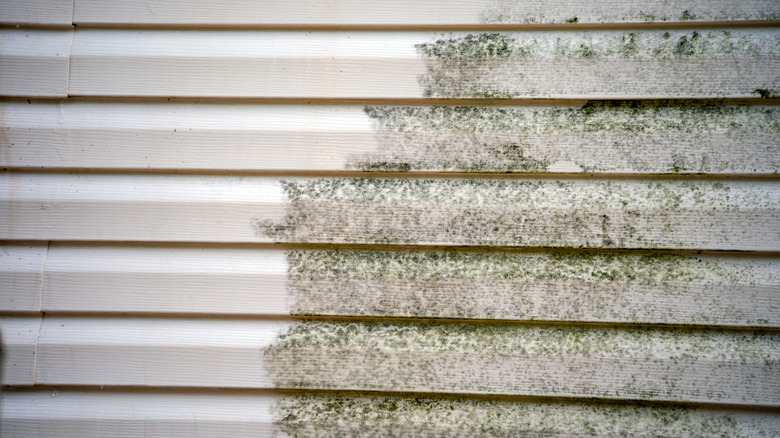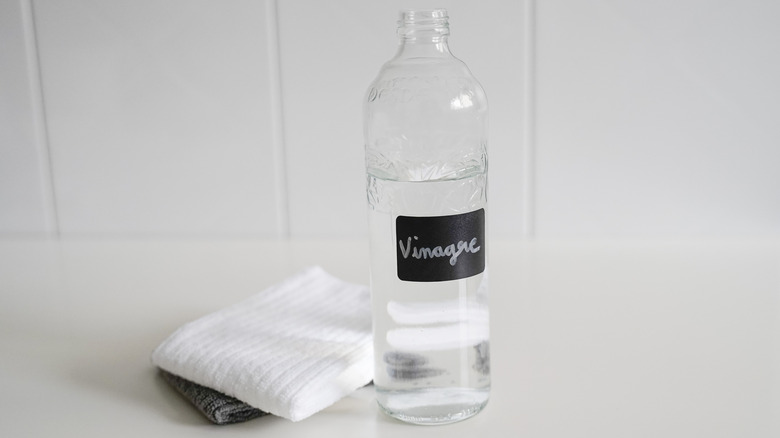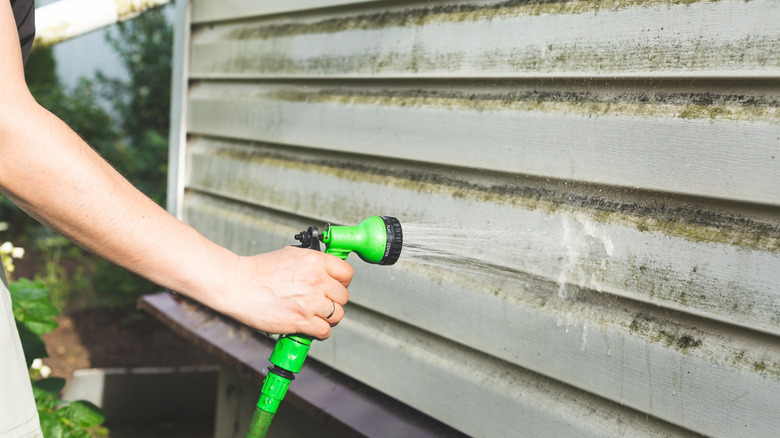Why Vinegar Is Your Secret Weapon To Cleaning Mildew From Vinyl Siding
Vinyl siding is a popular choice for homeowners, however, certain climate conditions make it more susceptible to weather-related issues, including mold and mildew. Thankfully, the best way to make your vinyl siding look new again is with a household staple you may already have. Vinegar is indeed a secret weapon for cleaning mildew and mold from vinyl siding due to its acidic properties.
While vinyl siding is known for being relatively low maintenance, mold and mildew can accumulate due to moisture, dirt, surrounding plants, tree sap, and lack of sunlight. Leaving bacteria and grime on your home's exterior may have negative consequences, such as increased health risks, lower home value, and damage caused by rot, leading to unexpected and potentially pricey repairs. Therefore, the moment you see signs of mildew, consider cleaning and sanitizing it with a simple vinegar solution.
As with any material around your home, you'll need to continually care for and maintain your vinyl siding to prevent mildew and mold. However, this effective homemade cleaner makes the job easy. Not only will you save money, but you'll also protect your vinyl surface and avoid harmful chemicals altogether. Let's dive into what makes vinegar such a powerful weapon against mold and how to use it on your home's exterior.
Vinegar is a secret weapon for vinyl siding cleaning
Many people use vinegar in their everyday cleaning regimen as it's incredibly effective on both indoor and outdoor surfaces. While you can use the vinegar in your pantry, cleaning vinegar is typically more effective; the difference between white vinegar and cleaning vinegar is that the latter has higher acetic acid content. Bacteria and fungi, including mold, don't survive in acidic environments, so spraying a vinegar concentrate solution of 30% or higher can help sanitize your vinyl siding. Vinegar's acetic acid penetrates the surface, effectively killing the bacteria from its roots. It can also help deter future mold and mildew outbreaks with routine cleaning. However, if the bacteria keeps returning even after your vinegar treatment, you may have additional problems, such as a leak, and a specialist may be required to examine the issue.
Many people choose commercial cleaners because of their effectiveness at eradicating mildew. However, these solutions are pumped full of abrasive chemicals that can damage your vinyl siding over time and may cause harm to the surrounding greenery. A benefit to cleaning with vinegar is that it is gentler on surfaces like vinyl, especially when diluted with water. It is also non-toxic and more environmentally-friendly than store-bought cleaners. Vinegar effectively targets organic material without the need for bleach and other strong chemicals. Plus, it's easy to work with — all you need is a pair of gloves, goggles, and a garden hose or pressure washer on a low-pressure setting.
How to clean your vinyl siding with vinegar
Now that you know the benefits of vinegar, it's time to learn how to make an effective cleaning solution. Start by creating a mixture of 70% water and 30% vinegar. Put on some protective gear such as rubber gloves, goggles, and long sleeves, as vinegar can cause irritation to your eyes and exposed skin. Apply the mixture to the siding with the spray attachment of your hose or by adding it to the tank of your pressure washer. Spray from the bottom to the top, ensuring there are no streaks. To effectively penetrate mildew, let it sit for up to 30 minutes before rinsing it clean. Scrub those pesky stains with a soft brush. While you may want extra cleaning power, never mix vinegar with bleach, as this could cause a harmful chemical reaction.
Keep mold and mildew away by routinely washing your home's exterior, especially if you live in a humid area. Be sure to do a deep clean every spring, which is the best time of the year to clean your vinyl siding. It's important to remember that vinegar may leave a lingering odor, especially right after application. The smell should wear off after a few hours, especially with direct sun exposure. The downside is that nearby plants could be affected by the vinegar, so be sure to rinse them well with water afterwards. It also can't lift stubborn stains, so you may need to add mild detergent or use a commercial vinyl siding cleaner on those areas in particular.


